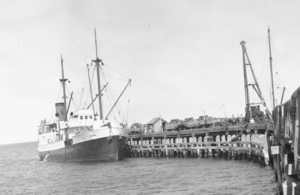
HMAS Cootamundra (J316/M186), named for the town of Cootamundra, New South Wales, was one of 60 Bathurst-class corvettes constructed during World War II, and one of 36 initially manned and commissioned solely by the Royal Australian Navy (RAN).

HMAS Kiama, named for the coastal town of Kiama, New South Wales, was one of 60 Bathurst-class corvettes constructed during World War II, and one of 36 initially manned and commissioned solely by the Royal Australian Navy (RAN).

HMAS Maryborough (J195/B248/A122), named for the city of Maryborough, Queensland, was one of 60 Bathurst-class corvettes constructed during World War II, and one of 20 built on Admiralty order but manned by personnel of and commissioned into the Royal Australian Navy (RAN). She was the first naval vessel built in Queensland for the Royal Australian Navy during World War II.

HMAS Mildura (J207/M207), named for the city of Mildura, Victoria, was one of 60 Bathurst-class corvettes constructed during World War II, and one of 36 initially manned and commissioned by the Royal Australian Navy (RAN). The ship was laid down by Morts Dock & Engineering Co in 1940 and commissioned into the RAN in 1941.

HMAS Pioneer was a Pelorus-class protected cruiser built for the Royal Navy at the end of the 19th century. She was transferred to the fledgling Royal Australian Navy (RAN) in 1912. During World War I, the cruiser captured two German merchant ships, and was involved in the East African Campaign, including the blockade of the cruiser SMS Königsberg and a bombardment of Dar-es-Salaam. She returned to Australia in late 1916 and was decommissioned. Pioneer was used as an accommodation ship for the following six years, then was stripped down and sold off by 1926. The cruiser was scuttled outside Sydney Heads in 1931.

HMAS Manoora was an ocean liner that served in the Royal Australian Navy (RAN) during World War II. She was built in Scotland in 1935 for the Cairns to Fremantle coastal passenger run for the Adelaide Steamship Company. She was requisitioned by the RAN for naval service in 1939. Manoora was initially converted into an armed merchant cruiser (AMC), operating primarily in Australian, New Guinea, and Pacific waters, with deployments to Singapore and the Bay of Bengal.
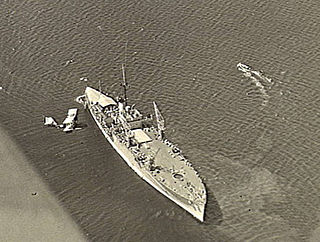
HMAS Albatross was a seaplane tender of the Royal Australian Navy (RAN), which was later transferred to the Royal Navy and used as a repair ship. Albatross was built by Cockatoo Island Dockyard during the mid-1920s and entered service at the start of 1929. The ship experienced problems with the aircraft assigned to her during her career: the amphibious aircraft she had been designed for were retired just before the ship entered service, the replacement aircraft could not be catapult-launched from the ship, and a new plane designed specifically to work with the ship began operations after Albatross was demoted from seagoing status in 1933.

HMAS Bungaree was a cargo steamship. She was built in Scotland in 1937 as Bungaree for the Adelaide Steamship Company of South Australia. The Royal Australian Navy requisitioned her in 1040, and had her converted into a minelayer. She was Australia's only minelayer in the Second World War, and laid more than 10,000 mines. In 1944 she changed rôles, becoming first a survey ship, and then a stores ship. The Navy returned her to her owners in 1947.

HMAS Cessnock (J175/B240/A114), named for the town of Cessnock, New South Wales, was one of 60 Bathurst-class corvettes constructed during World War II and one of 20 built for the Admiralty but manned by personnel of and commissioned into the Royal Australian Navy (RAN).
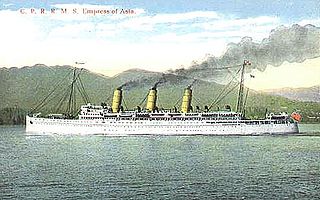
RMS Empress of Asia was an ocean liner built in 1912–1913 by Fairfield Shipbuilding and Engineering at Govan on the Clyde in Scotland for Canadian Pacific Steamships.
Silvanus was a steam tanker built in 1920–1921 by the Southwestern Shipbuilding & Drydock Company of San Pedro for the Anglo-Saxon Petroleum Company with the intention of transporting oil and petroleum products between Dutch East Indies and various destinations in Europe and the Far East. The tanker was employed in this capacity through the first part of 1926. In April 1926 Silvanus collided with the tanker Thomas H. Wheeler in the Mississippi River, resulting in the explosion and death of 26 seamen. Silvanus was declared a total loss and sold at auction to the newly formed Petroleum Navigation Company of Texas. The tanker was rebuilt and renamed Papoose and started operating in March 1927. In March 1942, she was attacked by German U-boat U-124 off the coast of North Carolina. The ship drifted for several days and eventually sank in 200 feet (61 m) of water off Oregon Inlet.

HMAS Goorangai was a 223-ton auxiliary minesweeper of the Royal Australian Navy (RAN). She was built in 1919 for the Government of New South Wales, then sold in 1926 to the fishing company Cam & Sons. The trawler was requisitioned for military service following the outbreak of World War II, converted into a minesweeper, and assigned to Melbourne. She was sunk in an accidental collision with MV Duntroon in 1940, becoming the RAN's first loss of World War II, and the first RAN surface ship to be lost in wartime.

HMAS Durraween (F93) was an auxiliary minesweeper operated by the Royal Australian Navy (RAN) during World War II. The ship was built as a trawler by Collingwood Shipbuilding Company at Collingwood, Ontario, Canada, and launched in 1918 as Seville. The ship served briefly in the Royal Canadian Navy during the last months of World War I, before being laid up and sold to a British company. In 1928, she was sold to Sydney-based fishing company and operated in Australian waters until she was requisitioned by the RAN in mid-1940 for use as an auxiliary minesweeper during World War II. Durraween operated in the Bass Strait as part of Minesweeping Group 54, and was responsible for clearing mines laid by German merchant raiders, and then later operated around the Torres Strait. She was returned to civilian service after paying off in late 1945, and was broken up in 1952.
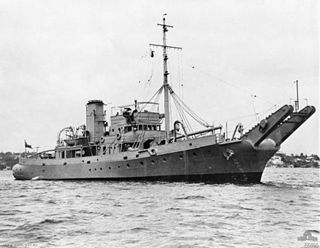
HMAS Karangi was a Kangaroo-class boom defence vessel operated by the Royal Australian Navy (RAN) during World War II. The third of three ships constructed by the Cockatoo Docks and Engineering Company at Cockatoo Island Dockyard based on the British Bar-class, Karangi was launched on 16 August 1941. After the war, the ship remained in active service with the RAN and played a small but key role in the British nuclear testing program. She was placed in reserve in 1953. In 1955, Karangi was reactivated and served for another two years until May 1957 and was eventually sold for scrap in 1966.

HMAS Mallina was a 3,213 GRT cargo ship built by Harland & Wolff, Belfast in 1909 as Mallina for the Australian United Steam Navigation Company for the Rockhampton to Sydney cargo route. She was requisitioned by the Royal Australian Navy in 1914, as a store carrier and collier. She was returned to her owners in 1915. She was sold in 1935 to Machida Shokai Kisen Kaisha, Japan and renamed Seiko Maru, before being sold to Kita Nippon Kisen Kaisha and renamed Siberia Maru No. 3, which was later shortened to Siberian Maru. While steaming in the Sulu Sea, Philippines on 24 September 1944, she was attacked by American aircraft of Task Force 38 and sunk with the loss of 158 of the 2,382 people on board.
The Cockatoo Docks & Engineering Company was a ship building and maintenance company which operated the Cockatoo Island Dockyard on Cockatoo Island in Sydney, Australia, between 1933 and 1992.

Kuramia was a K-class ferry on Sydney Harbour. Commissioned in 1914, the timber-hulled steamer was built for Sydney Ferries Limited during the early twentieth boom in cross-harbour ferry travel. At 353 tons, she was the largest wooden ferry on Sydney Harbour.
Portmar was a United States-flagged merchant vessel that was constructed in response to World War I, operated by a succession of companies in the interwar period, then taken up for wartime shipping in World War II.

Cokesit was a steam cargo ship built in 1918–1919 by Guy M. Standifer Construction Company of Vancouver for the United States Shipping Board as part of the wartime shipbuilding program of the Emergency Fleet Corporation (EFC) to restore the nation's Merchant Marine. The vessel was largely employed on the East Coast of the United States to Australia route until 1928 when she was laid up. In late 1937 the ship together with several other vessels was bid on and subsequently acquired next year by the Greek tramp operator John D. Chandris to carry cargo from Australia to Greece and United Kingdom. The freighter was also renamed Adelfoi Chandris. Following the surrender of France, the ship was interned in Dakar and passed into Vichy government hands in 1940 and renamed Saint Marin. Under the terms of Nevers Agreement she eventually was transferred to Italy and renamed Catania. In early August 1943 the vessel together with several other ships was bombed and damaged in Naples harbor by the Allied aircraft.
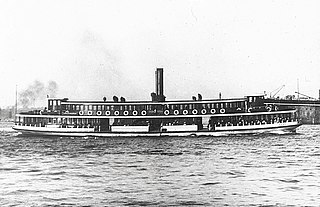
Kaikai was a "K-class" ferry on Sydney Harbour. Commissioned in 1907, the timber-hulled steamer was built for Sydney Ferries Limited during the boom in cross-harbour ferry travel prior to the 1932 opening of the Sydney Harbour Bridge. At the time of launch, Kaikai was one of Sydney's largest wooden ferries, being the longest and second largest by tonnage. She was a typical example of the "K-class"; a group of double-deck, double-ended, steam-powered screw ferries.
